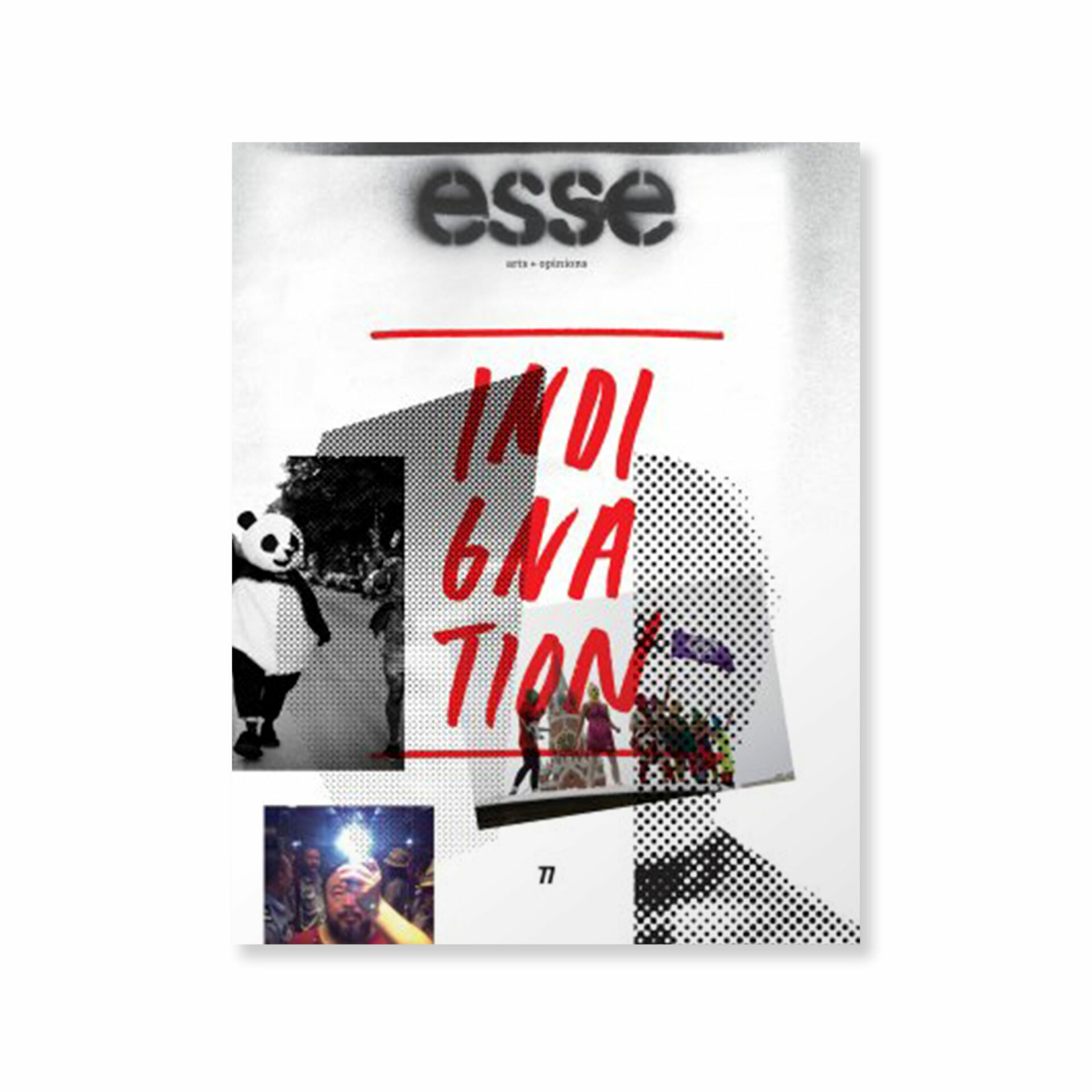
Photo: © Jérémie Battaglia
In today’s world, it is crucial to combine critique with creativity, thought with emotion and passion, theory with active social engagement (Own translation).
Rosi Braidotti
This past spring, Quebec witnessed a surge of indignation shared by hundreds of thousands of striking students1 1 - In the original French version of this article, the authors use a unique written form that includes both the masculine and feminine genders. , a collective act of resistance against a drastic hike in tuition fees.2 2 - A 75 % increase over five years Drawing record-breaking numbers,3 3 - At the height of the movement, between 300,000 and 310,000 students were on strike. the movement generated countless acts of protest that had a unique visual quality. In a context of citizen revolt, these tactics encouraged political subjectifications that helped to redefine in a wholly new way the practices of democracy in Quebec society.
The tuition hikes are part of a series of neoliberal measures and policies which, when implemented in Quebec and elsewhere in the West, serve to “de-democratize” (to borrow Wendy Brown’s term) the sharing of power: “[N]eoliberalism as a political rationality has launched a frontal assault on the fundaments of liberal democracy, displacing its basic principles of constitutionalism, legal equality, political and civil liberty, political autonomy, and universal inclusion with market criteria of cost/benefit ratios, efficiency, profitability, and efficacy… the state is forthrightly reconfigured from an embodiment of popular rule to an operation of business management.”4 4 - Wendy Brown, “We Are All Democrats Now…” Democracy in What State? (New York: Columbia University Press, 2011), 47. The protesters were well aware that the tuition increase was symptomatic of a global context in which the growing privatization of funding is leading to the commodification of education. This was also the subject of their critique as they raised their voices against the government then in power, which simply turned a deaf ear. Discovering direct democracy through assembly, the students first courageously voted to declare an unlimited strike. The streets became the forum in which they expressed their discontent, joined by thousands of others who supported their cause. The passing of Law 12 (Bill 78) on May 18 sparked the indignation of an even wider breadth of society;5 5 - See the Manifeste des professeur.e.s pour la protection de la démocratie et du droit de protestation des étudiants-es. people suddenly became aware of the threat to democracy and the limits being placed on the exercising of democratic rights. In retrospect, the occupations, protests, and various actions staged in Quebec last spring can be seen as enthusiastic efforts to safeguard a democracy founded in this instance on participation.
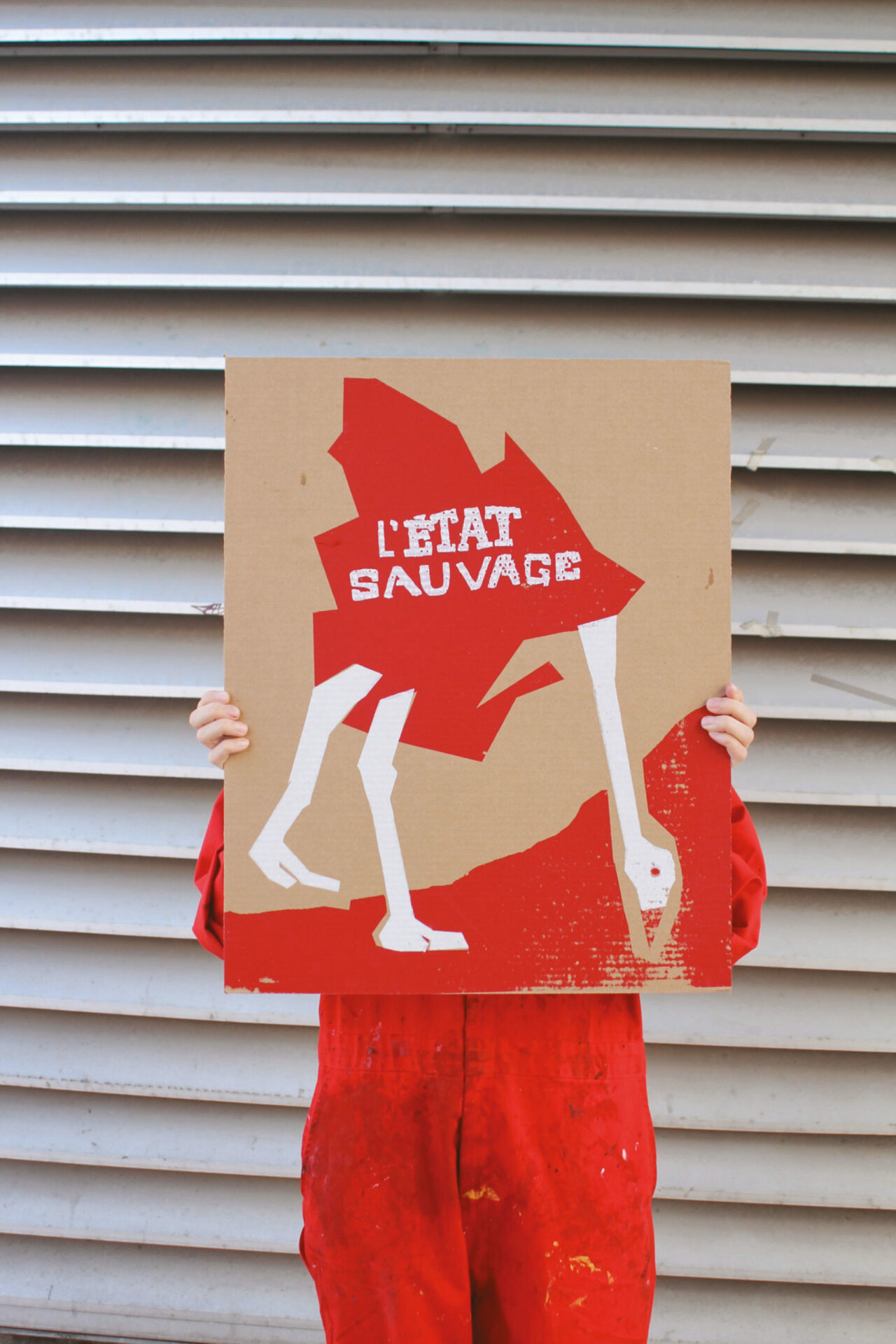
L’état sauvage, 2012.
Photo: courtesy of l’École de la Montagne Rouge
As philosopher Fabienne Brugère states from a Foucauldian perspective, democracy “is always in the making, carried by the practices that give it form. To participate is to practise democracy.”6 6 - Fabienne Brugère, Faut-il se révolter?, Le temps d’une question (Coll.) (Paris: Bayard, 2012), 92 (Own translation). The practice of democracy “implies subjectifications, détournements, and lifestyles because it is materialized through individuals who take hold of directives and transform them as they transform themselves.”7 7 - Ibid.,94. In appropriating the rules that govern them, users make audible their dissent, and through acts of refusal and disobedience affirm “minority counter practices”8 8 - Ibid., 96. that defy authority — in this instance, the neoliberal regime and its “management” of the common good, including education. Participation gives rise to countervailing views that are an integral part of democracy, but that the government of Jean Charest roundly dismissed — paradoxically, in the name of democracy.9 9 - A scorn examined by Jacques Rancière in La haine de la démocratie (Paris: La Fabrique, 2005). This context therefore highlighted the crucial role played by the protest actions, which both revived democracy and spurred creative output. The protest movement created a grey area in which norms were shifted and turned on their head.
Consequently, for us, indignation marks but the stage of realization, the catalyst for the truly significant protest actions that ensued. Indignation called for action — ideally liberating action.
Urban Economies
Over the course of weeks of nightly marches, protestors covered thousands of kilometres, resolutely taking over streets and other spaces. These marches embodied the progress of the social movement — a determined, lasting and impassioned force coloured by anger and joy. “We’re moving forward, not back” was an oft-chanted slogan. The street became a space for people to gather and walk together during improvised protests that could have resembled Situationist dérives had it not been for the large number of participants. Chosen voluntarily or in response to recurring constraints, the routes revealed distinctive features of the urban fabric and the constant presence of the police as a force of control and repression — on horseback, bicycle or foot, and in anti-riot formation. On Berri Street, the protestors often marched up the hill to get a good view of their numbers. Just as insistently, they were pushed back by the police who stopped them from marching down Saint-Catherine Street towards the sacrosanct Quartier des spectacles, the ultimate symbol of commodification.
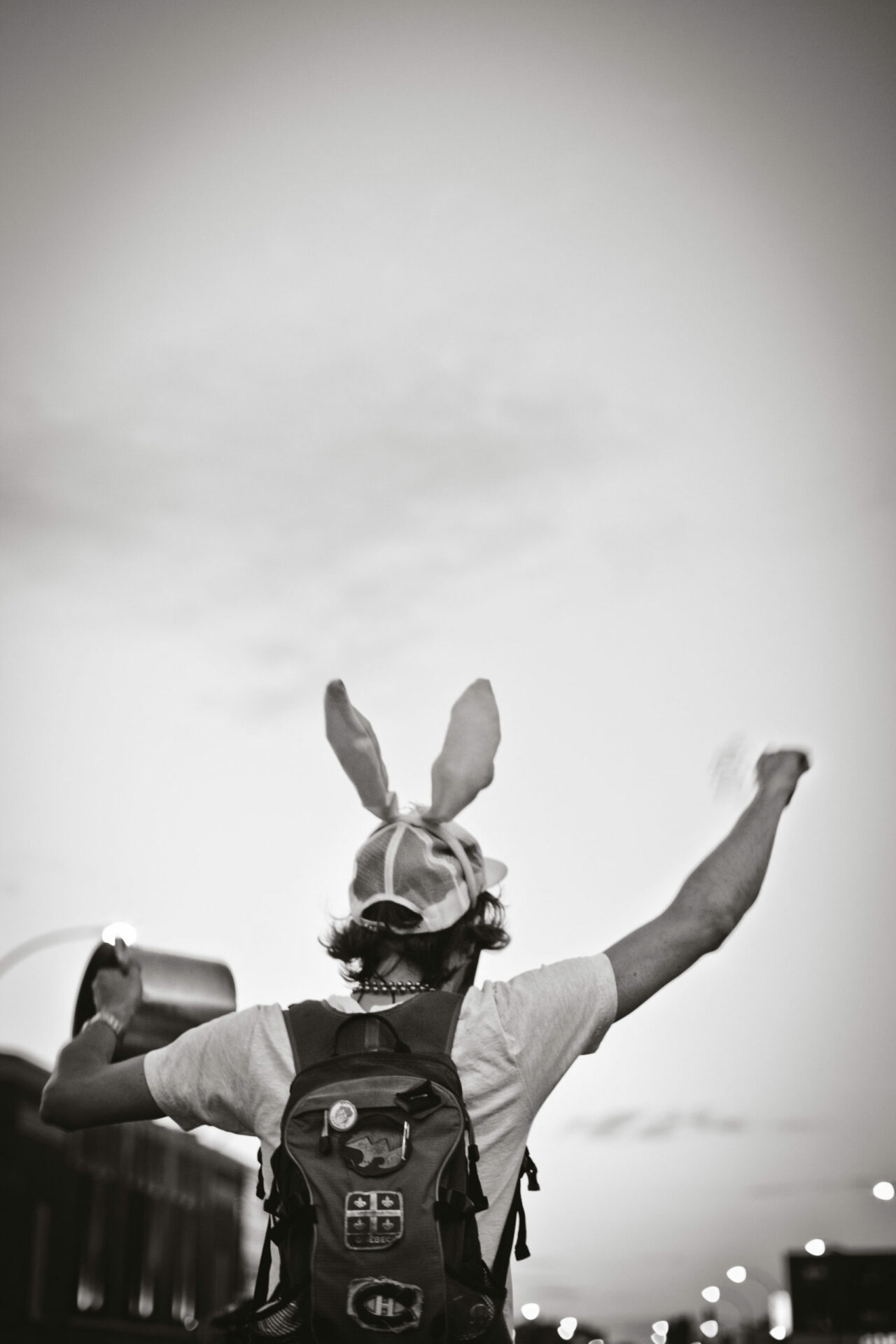
A member of Rabbit Crew protesting in Villeray, 2012.
Photo: © Jérémie Battaglia
Sometimes the train of protestors followed routes that revisited the same landmarks — sites of power that were obvious targets. Other less typical itineraries were chosen to heighten the movement’s visibility and to appropriate the city in unexpected ways. The marches led by the Rabbit Crew were examples of this phenomenon. The shape-shifting collective found ingenious ways to avoid police surveillance by cheerfully scampering along and rethinking their route each time they reached an intersection, at which point they consulted a rudimentary compass. Nobody was afraid to advance with them on roadways, even those running alongside a highway.10 10 - As part of the 12-hour “general unlimited strike” held on April 11 in downtown Montreal, with a new theme every hour. Disgruntled drivers could do nothing in face of this festive, jubilant, and liberating march with a strong playful element. As philosopher Martha Nussman has noted, play “teaches people to be capable of living with others without control: it connects the experiences of vulnerability and surprise to curiosity and wonder, rather than crippling anxiety.”11 11 - Martha Nussman, Not for Profit. Why Democracy Needs the Humanities (Princeton: Princeton University Press, 2010), 101. In this sense, despite the gravity of the claims and the violence with which the government expressed its disdain towards the protestors, a ray of hope nonetheless emerged.
In response to police repression, the protestors staged the “Grande masquerade” — four simultaneous protests identified as yellow, orange, green, and blue. By using the colours of Montreal’s metro lines, the protestors cleverly adapted the codes of commuter travel to their own purposes. The carnivalesque chaos that ensued — playful but at times hostile — was to some reminiscent of the charivari protest tradition used by the Patriots.12 12 - Gilles Laporte, “Le charivari comme arme politique,” Le Devoir, March 30, 2012, A10. Jean-François Nadeau, “Grogne populaire. Du charivari historique à la casserole politique,” Le Devoir, May 30, 2012, A1. If the protestors had to provide their route in advance, as Bill 78 would later require, what better way to show transgression instead of submission than to create a metro-like map in the shape of a finger salute?
The protestors marked the city by transforming thoroughfares and urban spaces into sites of collective action and experimentation, and by reinventing ways of being and acting together. Often dressed in red, their combined bodies created a continuous line, symbolizing the extent of their movement and reinventing the traditional picket line. UQAM theatre students formed a “red line” along the platform at Jean-Talon metro station; school crossing guards against the hike made sure pedestrians were able to cross at crowded intersections; and architecture students from the Archicontre collective marched with their heads hidden inside red boxes. In addition to these mobile formations, there were also blockade actions such as those carried out by the students of Légion D, who made it difficult for objectionable ministers to reach their destinations.
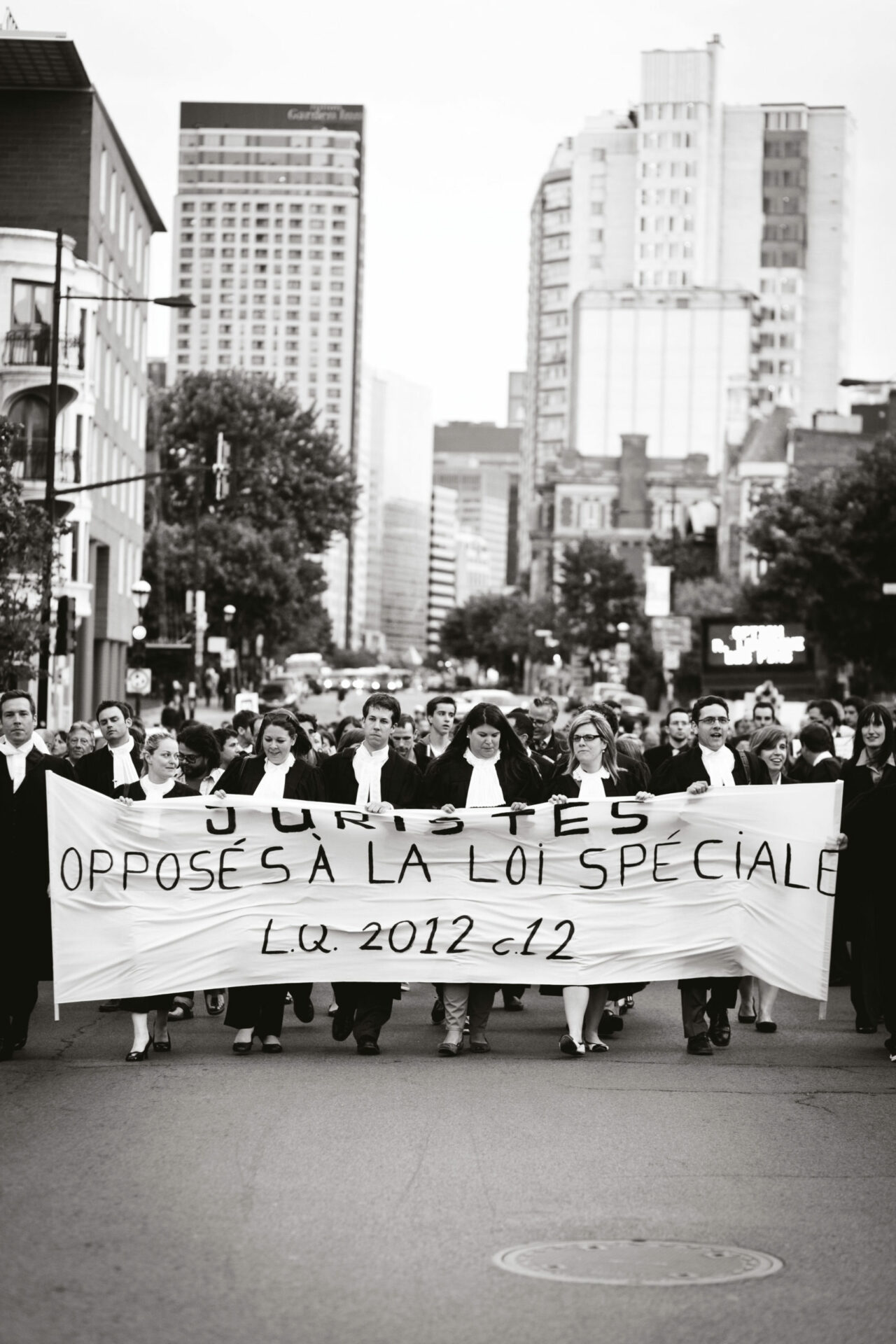
Lawyers marching against the special law, 2012.
Photo: © Jérémie Battaglia
This multi-sited occupation of the urban landscape was just as important as the rhizome-like formation of groups of sympathizers on the sidelines, such as unions. An impressive number of smaller anti-hike groups were also formed, lending a popular, social aspect to the student movement. These included Profs against the hike, Parents against the hike, Retirees against the hike, Artists against the hike, Crayons against the hike, and related groups such as “Tête blanche carré rouge” (grey hair red square) “Mère solidaires et en colère” (angry mothers in solidarity) and neighbourhood groups like the Association populaire autonome de quartier. One of the most repeated slogans during this time was “La grève est étudiante, mais la lutte est populaire” (the student strike is the people’s struggle).
The street became a school, teaching us about the theory and practice of politics. The street replaced courses in philosophy, political science, literature, visual arts. Even more, it became a place of synthesis, for all forms of expression, from street protest to neighbourhood party. The “Dance your strike” group added a rhythmic element to the marches; the “People’s choir” could be heard in the streets and parks; Fermaille and the École de la montagne rouge used the red square and the colour red in a variety of graphically innovative ways. “Words and images” gave a voice to poets, writers, pamphleteers, and citizens. Works ranging from major literary classics (The Red and the Black) to the children’s series Martine (Martine est copine avec les Rabbit Crew) were enlisted in the struggle. As were famous paintings such as that of Borduas — an anti-establishment artist known from his Refus global (Total Refusal) manifesto as a model of a necessary or even vital revolution — on which a painterly red square was affixed, signifying a parallel between the strike and the politics of an artist who refused illegitimate values and constraints.
The colour red, much like abstraction in the past, seemed to threaten the forces of order and reason. The colour of the strike, much maligned by the State, spread like wildfire: the red of the École de la montagne, red work uniforms, the Boîte rouge media group, the “red line” of students at Jean-Talon metro station, the Fil rouge (red wire) committee, red-themed picnics and yoga sessions, and trees decorated with red square leaves. Red felt became a scarce commodity; red fabric was in high demand. In one event that could be seen as a collective performance, participants went so far as to have the red square tattooed onto their skin.
Others, like those who put together the paper Ceci n’est pas la matraque des profs contre la hausse13 13 - This paper was created by a committee of the “Profs against the hike” group., used the power of words (à la Magritte) to affirm their refusal of violence masquerading as order. Among the many ingenious word plays that emerged were “Maple Spring,” “maNUfestation,” “manifestin,” “l’Oie spéciale” and “rêve général illimité.”14 14 - MaNUfestation” (nu = naked) and “manifestin” (festin = feast) are humorous takes on “manifestation” (protest). “L’Oie spéciale” (special goose) is a play on “Loi spéciale” (special act/emergency legislation) and “Rêve générale illimitée” (general unlimited dream) refers to the “Grève générale illimitée” (general unlimited strike).
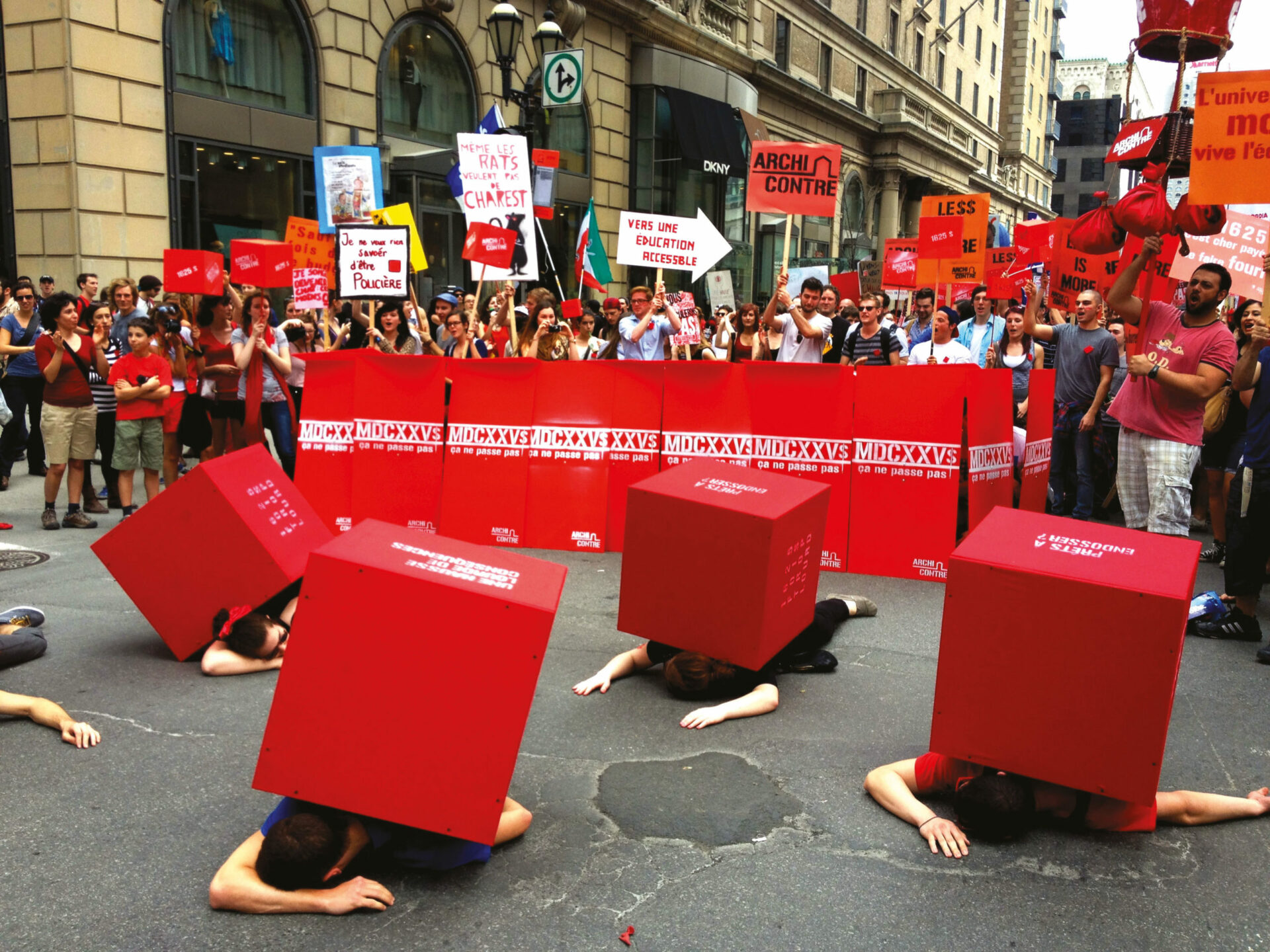
Protest action by architecture students from Université de Montréal, March 2012.
Photo: Gabrielle Morin, © collectif ArchiContre
Economy of Means
The urban space was not only occupied by an intellectual elite. The domestic sphere also came out onto the street to serve the cause — the almost-deafening banging of pots and pans being the most obvious example. Behind the scenes, in a show of solidarity, young men and women knitted red squares to be worn by protestors or tied around trees along protest routes. Formerly the domain of girls, the skilled art of “home economics” as it was once known, was revived in a context denouncing the forced impoverishment resulting from neoliberal policies. In an impressive show of efficiency and determination, the activists countered the economy of knowledge that some would like to see founded on market values, with an economy of means—using whatever resources they had on hand to produce anti-establishment objects and symbols. Some examples among many include the return of the artisanal printing press (École de la Montagne Rouge) and the printing of a popular magazine (Urbania).
Daily life also found its way into food metaphors that were more playful than threatening. The character of the “rebellious banana” and the declaration that “pepper is for steak” invested the fruit and condiment with political meaning, countering the authorities’ announcement that the strike was illegal. The forces of law and order were also the object of easily recognizable satirical references, for example when the protestors dangled donuts on the end of fishing lines in front of a row of policemen who were missing out on their daily snack. Or the image of a steaming plate of “Poutine” on which “Bill 78” was written. Written with a capital “P,” the popular Quebec dish evoked the name of president Putin and the dictatorial Russian regime.

Pot-banging in Villeray with Anarchopanda, 2012.
Photo: © Jérémie Battaglia

Illegal mass of fingers (Own translation), April 30, 2012.
Photo: Clément de Gaulejac
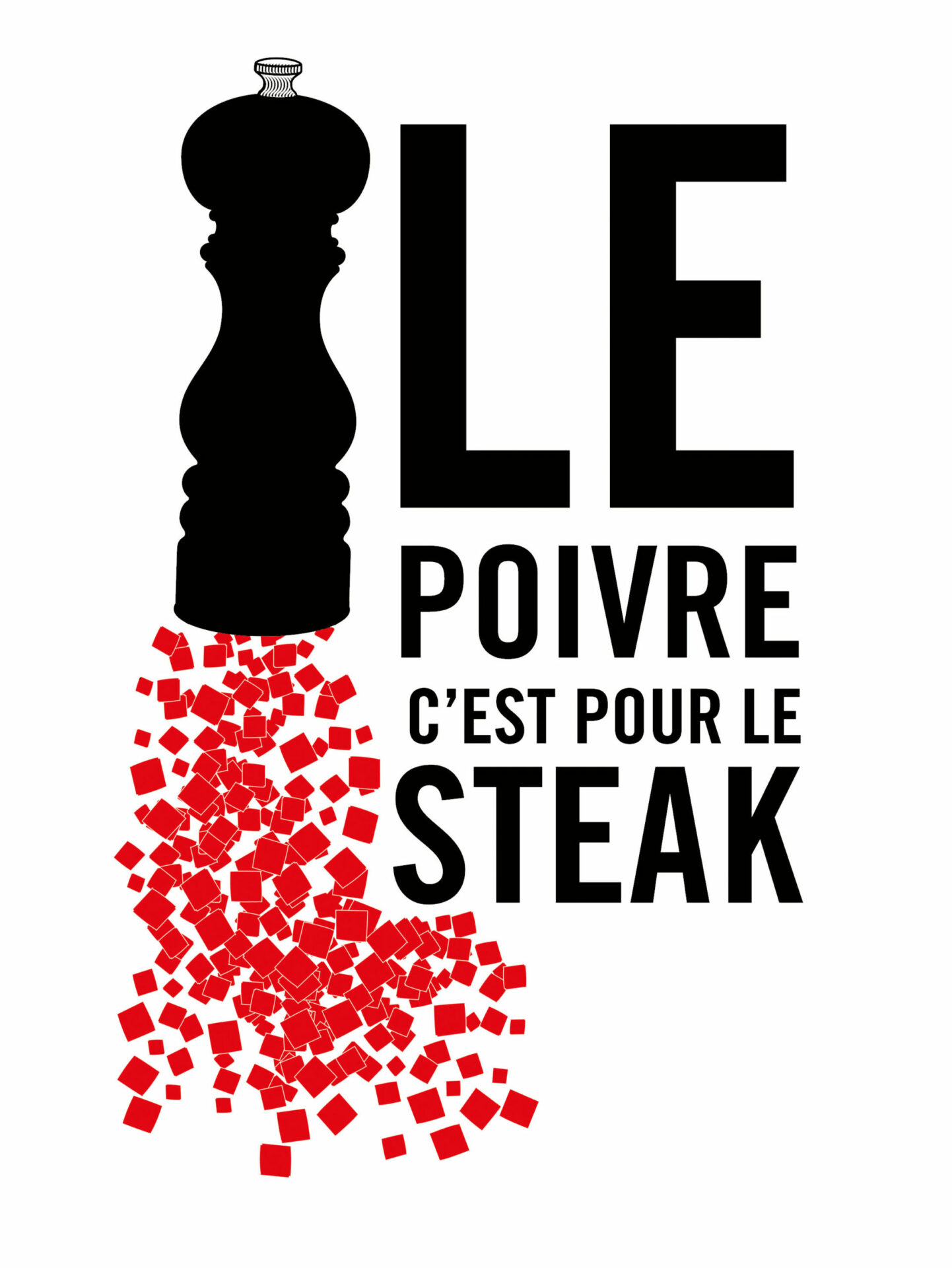
Pepper is for Steak (Own translation), April 12, 2012
Photo: Clément de Gaulejac
Individual protestors, who we here refer to as citizens, sometimes wore disguises, thus making themselves invisible. One wore a panda suit and cuddled police officers; others wore the omnipresent Anonymous mask. In contrast, some protestors confronted the masked and helmeted officers of the law fully naked or only partially clothed. The act of undressing — more a demonstration of having “nothing to hide” than a provocation — countered the symbolic force of the police uniform and the very real force of the baton.
Students were not the only ones occupying the streets. Citizens shared their critical stance toward the economy of knowledge and learning, the foundation of knowledge itself. In a context in which the law overrides social injustice, inciting civil disobedience, we would do well, within our respective disciplinary fields, to focus on what Rosi Braidotti, following Foucault, calls “epistemological disobedience.”15 15 - Rosi Braidotti, La philosophie… là où on ne l’attend pas (Paris: Larousse, 2009), 129 (Own translation). In a context that calls for action, we believe that “in our thinking, the challenge is no longer to grapple with the eternity of pure reason, but rather to express the inherent imperfection of situated thought that is both individual and collective.”16 16 - Ibid., 9. This type of intellectual thinking finds its place in a community of spirits for whom knowledge and learning must be accessible to all, beyond the normative spaces that the commodification of education is seeking to reinforce.
[Translated from the French by Vanessa Nicolai]
